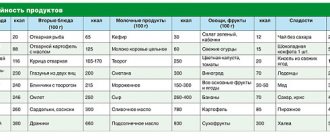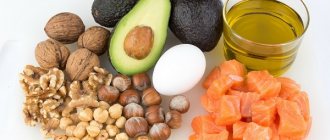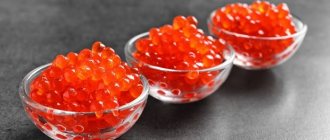Chocolate is a confectionery product made from cocoa beans ground with sugar. Depending on the concentration of cocoa in chocolate, there are black, dessert, milk and white chocolate. Due to its unique properties, chocolate is one of the most popular desserts. The calorie content of chocolate is a variable concept. The energy value of chocolate depends not only on the mass fraction of cocoa, but also on other additives used in the manufacturing process. What are the beneficial properties of chocolate? How many calories are in different types of chocolate? How to combine chocolate and diet?
Chocolate: varieties, calorie content of chocolate, beneficial properties
Chocolate and its beneficial properties are still the subject of debate among doctors, many of whom agree that chocolate is an indispensable component of the diet due to its high content of nutrients, nutritional properties and taste.
Nutrient composition of chocolate:
- Carbohydrates – from 48 to 55 g;
- Fats – 32-38 g;
- Proteins – 4.7 – 6.2 g.
Chocolate also contains alkaloids (theobromine and caffeine - up to 1%) and phenylethylamine (up to 0.5%):
- Phenylethylamine is a chemical substance, the basis of many neurotransmitters; derivatives of this substance are psychedelics and stimulants;
- Theobromine is an alkaloid with properties similar to caffeine; in low dosages it causes stimulation of the heart muscle;
- Caffeine is an alkaloid that is a powerful psychostimulant.
It is these substances in chocolate that affect the emotional centers of the brain, causing a feeling of some euphoria, helping to improve mood, and also determining the properties of chocolate as an antidepressant. The concentration of these substances in chocolate is negligible, which makes this product absolutely safe for humans.
The calorie content of chocolate in 100 g of product reaches 680 calories and will depend on the composition and fillings of the treat. At the same time, the calorie content of chocolates is slightly lower and reaches 480 calories per 100 g of product.
Chocolate contains a number of vitamins, micro- and macroelements, the most important of which are potassium, magnesium, iron, phosphorus, as well as vitamins PP, B1, B2, E.
Despite the relatively high calorie content of chocolate, this product has unique properties:
- Tannin stimulates the gastrointestinal tract, promotes the removal of toxins from the body, providing a mild laxative effect;
- Potassium and magnesium activate the muscular and nervous systems, which makes chocolate a particularly useful product for people involved in sports. Magnesium stimulates the rhythm of the heart and ensures the transmission of nerve impulses. Potassium has a normalizing effect on blood pressure;
- Glucose improves brain activity, increases ability to work, reduces mental fatigue;
- The combination of cocoa butter and sugar has a stimulating effect on the production of serotonin and endorphin in the brain;
- Phenols in chocolate prevent the narrowing of blood vessels, the formation of blood clots, stimulate blood flow, thereby reducing the load on the heart;
- Theobromine and caffeine increase the body's resistance to stress.
The high calorie content of any type of chocolate helps to quickly saturate the body and keep you full for a longer period of time.
Despite the high calorie content of chocolate, this product does not lead to obesity when consumed in moderation. It is also recommended to consume chocolate in limited quantities for hypertension, diabetes, and various heart diseases.
The results of some independent studies have shown that regular consumption of chocolate in small quantities reduces the risk of developing gastrointestinal ulcers, various neoplasms, and also enhances the body's protective functions.
Compound
Let's consider what ingredients are included in the product, in what quantities, as well as what beneficial compounds are present in milk chocolates.
What are regular and porous made from?
According to GOST 31721-2012 (interstate standard), milk chocolate is chocolate made from cocoa, milk and sugar. According to the rules, it must contain at least:
- 25% total cocoa solids;
- 25% total fat;
- 12% milk powder or its processed products;
- 2.5% milk fat;
- 2.5% non-fat cocoa solids.
The main ingredients are cocoa butter, powdered or grated cocoa, milk and sugar. In most cases, vanilla is used as a flavoring agent, and soy lecithin is used as an emulsifier (for homogeneity and thickness of the mass). Various products are used as fillings - nuts, pralines, raisins and other dried fruits, candied fruits, berries, etc.
Aerated milk chocolate is made from the same components, so its composition differs from a monolithic bar only in the presence of air bubbles.
Nutritional value (BJU)
Data on BJU per 100 g are as follows:
- proteins – 9.8 g;
- fat – 35 g;
- carbohydrates – 50.5 g;
- dietary fiber – 1.3 g;
- water – 1 g.
These are average figures for chocolate without filling and fillers. They may vary slightly for different brands and types. For example, Alenka milk chocolate contains 8 g of protein, 33 g of fat and 54 g of carbohydrates, while for Nesquik these figures are different - 7.7 g, 34.1 g and 52.9 g, respectively.
What vitamins and microelements does it contain?
The richest in beneficial composition are the bitter varieties. However, dairy also contains mineral elements and vitamins, but in smaller quantities:
- Among the vitamins it contains, the leading ones are B2, PP and B5; it also contains B1, E, B9, B6 and A.
- Of the macroelements, most are phosphorus and calcium, slightly less potassium, magnesium, sodium and sulfur.
- Microelements are represented by manganese, copper, iron, iodine and fluorine.
Other useful substances
Chocolate owes its content of most biologically active and healthy substances to cocoa beans. The product contains theobromine, phenylethylamine, tryptophan, several antioxidants, flavonoids, and polyphenols. Some of them have a stimulating effect on the nervous system, others, on the contrary, soothe, others tone and rejuvenate, have anti-inflammatory and mild analgesic activity. But the listed effects are more pronounced in bitter and dark varieties than in dairy varieties.
Calorie content per 100 grams, how many calories are in a bar, in a slice
100 g contains 550 kcal. Calorie content deviates slightly in one direction or another for different manufacturers and depending on the specific composition. If chocolate contains nuts or dried fruits, the energy value increases. If we start from 550 kcal, take the weight of the bar as 100 g, and the number of slices in it is 6, then the calorie content of one slice will be 92 kcal. You can calculate the calories in a slice and cube of any brand of chocolate yourself in this way.
Dark chocolate: calorie content, composition
According to modern standards, chocolate containing 60% cocoa powder or more is bitter.
100 g of dark chocolate, the calorie content of which reaches 540 calories, contains up to 40% sugar, up to 30% cocoa butter and about 30% cocoa, which determines the composition of real chocolate. Dark chocolate, whose calorie content is slightly lower than the energy value of dairy varieties of this product, can also add nuts, coffee beans, candied fruits, wafers and other components that change the calorie content of chocolate. Recently, chocolate with various candy fillings has become especially popular. When purchasing chocolate, you need to pay special attention to its composition. Cocoa butter is an expensive ingredient and is often replaced with cheaper fats (palm, coconut, peanut oil, animal fats), which significantly increase the calorie content of chocolate, reducing its quality and taste.
Flavored chocolate drinks
People love to consume this famous delicacy not only in solid form, but also in the form of aromatic drinks. Actually, initially it was known in a liquid state. So, the ancient Mayans and Aztecs prepared hot chocolate. This unusual drink was seen by the Spanish conquistador Hernando Cortes, who brought it to the Old World. Europeans quickly appreciated the unusual taste of the chocolate drink. However, they prepared it less spicy, removing the chili pepper added by the Indians from the recipe. Later it was made sweet, thanks to which this delicacy began to gain numerous fans.
Advice from nutritionist Irina Shilina Healthy eating is incompatible with strict dietary restrictions, malnutrition and prolonged fasting. Today there is no need to strive for abnormal thinness by depriving yourself of food! Pay attention to the latest weight loss techniques for 2020. Find out the secret ->
Depending on the ingredients added, the calorie content of hot chocolate can vary greatly, but its average energy value is quite low - only 150 calories per hundred grams. Therefore, if you care about your figure, then it is preferable to consume this delicious dessert rather than a chocolate bar. Here are some recipes.
- The classic low-calorie version includes the following ingredients: dark chocolate, milk, a little potato starch for thickness.
- You can also make a hot drink by adding softened banana instead of starch. It will provide not only the necessary consistency, but also sweeten the drink. In this case, you can do without sugar, and the energy value will be only 108 calories per 100 grams.
- Mexican hot chocolate, which contains dark chocolate, milk, cayenne pepper, cocoa powder, cinnamon and sugar, will be more nutritious. Its average energy value is 216 calories.
Another interesting option is chocolate milk, which is extremely popular among children. This drink has a very long history, as it was invented back in 1680 by the English physician Hans Sloan. To prepare it, use any milk (cow's or goat's), which is mixed with melted chocolate or chocolate syrup. Sugar and vanilla can also be added to it. Chocolate milk is loved by athletes, as it is believed that it speeds up the body's recovery process after serious physical exertion.
At the same time, industrially produced milk can lead to rapid weight gain due to its high sugar content. In addition, with a fairly low calorie content (only 100 calories per 100 grams), it has a high fat content: 6 g per 100 g of product. Frequent consumption of this drink carries the risk of quickly becoming obese.
There are also a large number of alcoholic and non-alcoholic drinks based on chocolate syrup. For example, one hundred grams of chocolate liqueur contains 332 calories. But the alcoholic cocktail “Favorite Chocolate”, created on the basis of melted chocolate, butter and champagne, will add 307.5 calories. The “Chocolate Ice” cocktail (chocolate, red wine, cream, liqueur and ice) contains 263 calories in one hundred grams. An alcoholic drink based on dark chocolate and black pepper (milk, cognac, sugar, cinnamon and vanillin are also added) has a calorie content of 161.5 calories per 100 grams. The so-called chocolate “homemade Baileys” (vodka, egg yolks, concentrated milk or condensed milk, coffee and chocolate) reaches 278 calories per hundred grams in energy value.
Non-alcoholic drinks are no less high in calories. The Prague Summer cocktail (drinkable yoghurt, orange and peach juices, chocolate and coconut flakes) comes out to 220 calories. More suitable is a chocolate shake with tea and cocoa (with added milk, sugar and ice cubes) - 83.9 calories.
Milk chocolate: calories, composition
Milk chocolate, which has a calorie content of up to 550 calories, contains 20% milk powder, up to 30% cocoa (up to 15% cocoa butter) and up to 35% sugar. Due to its lower cocoa content, milk chocolate does not have the same beneficial properties as dark chocolate. However, it is milk chocolate that is recommended for children, since it does not have such a strong stimulating effect on the nervous system.
The milk and cream contained in milk chocolate, which is quite high in calories, has a calming effect and helps to effectively cope with insomnia and excessive agitation. Milk chocolate, unlike bitter chocolate, is recommended to be excluded from the diet.
Chocolate and diet: acceptable amounts
How many calories are in chocolate? The calorie content of chocolate can reach 680 calories depending on the ingredients and various flavorings. How can chocolate be combined with a diet if it is high in calories?
It should be noted that during the diet, only dark chocolate without flavoring additives (nuts, dried fruits, candied fruits, fondant fillings) is allowed. Chocolate affects the pleasure centers of the brain, and thus causes a feeling of satisfaction. Some nutritionists recommend finishing each meal during the diet with a small piece of chocolate, which will have enough stimulants to ensure a feeling of fullness. With such consumption of this delicacy during a diet, you can not take into account how many calories are in chocolate.
But milk chocolate and other chocolate products should be completely excluded from the diet, and the amount of their consumption in the regular diet should be reduced. Thus, the calorie content of chocolates is slightly lower than the calorie content of chocolate, but the candies do not have such beneficial properties, do not provide such a long-term feeling of satiety, and also do not cause a feeling of satisfaction.
To create a dietary diet, nutritionists recommend giving preference to varieties of dark chocolate with a high cocoa content (from 72% and above), the bright taste and nutritional properties of which can provide long-term satiety and satisfaction. At the same time, the calorie content of chocolate with a higher concentration of cocoa is significantly lower, since the calorie content of 100 g of cocoa is 400 calories.
The harm of chocolate
Chocolate is a dessert. It should be consumed in limited quantities. It provides the body with energy, but with heavy consumption of chocolate, carbohydrates are stored in reserves, turning into fat deposits. Chocolate contains a lot of sugar.
| Product | Kcal | Proteins, g | Fats, g | Angle, g | |
| Creamy chocolate | 560 | 6,3 | 35,5 | 53,7 | |
| Chocolate sweet | 550 | 3 | 34 | 57,6 | |
| Porous milk chocolate | 545,8 | 6,9 | 35,5 | 53 | |
| Semi-bitter chocolate | 549 | 4,5 | 35,4 | 52,5 | |
| Chocolate nuts | 534 | 7,3 | 33,8 | 49,7 | |
| Milk chocolate with raisins | 500 | 8 | 30,3 | 48,2 | |
| Milk-nut chocolate | 542 | 7,5 | 33,9 | 51,3 | |
| Chocolate powder | 482,5 | 5,2 | 24,3 | 64,8 | |
| Sweet confectionery tiles | 552 | 6,2 | 34,2 | 54,5 | |
| Pastry tiles | 537 | 7,8 | 34,6 | 48,1 | |
| Chocolate with nuts | 580 | 6,6 | 40,9 | 49,9 | |
| Milk chocolate | 550 | 6,9 | 35,7 | 54,4 | |
| Bitter chocolate | 539 | 6,2 | 35,4 | 48,2 | |
| Chocolate Air porous dark | 517 | 5,7 | 28,5 | 58,7 | |
| Chocolate Air porous white with hazelnuts | 550 | 5 | 32,6 | 58,6 | |
| Chocolate Airy Crispello | 520 | 5,4 | 27,1 | 62,7 | |
| White chocolate with coconut | 562 | 7,3 | 35 | 54,6 | |
| Chocolate white | 541 | 4,2 | 30,4 | 62,2 | |
| Baking chocolate | 492 | 5 | 27,5 | 56,1 | |
| Truffle chocolate | 553 | 6,7 | 37,6 | 48,1 | |
| Chocolate tiramisu | 431,33 | 12,8 | 29,13 | 28,63 | |
| Chocolatl | 149,44 | 3,56 | 8,54 | 14,74 | |
| Chocolate balls | 390 | 7 | 3,5 | 80 | |
| Fructose chocolate | 574 | 4,9 | 38 | 52 | |
| Chocolate pillows | 435 | 6,5 | 16,5 | 67,5 | |
| Aerated milk chocolate | 545,8 | 6,9 | 35,5 | 53 | |
| White aerated chocolate | 550 | 5 | 32,6 | 58,6 | |
| Chocolate is porous | 522 | 5,7 | 27,9 | 61,4 | |
| Creamy chocolate | 560 | 6,3 | 35,5 | 53,7 | |
| Chocolate bars | 492,7 | 13,51 | 21,39 | 45,84 | |
| Hot chocolate | 149,44 | 3,56 | 8,54 | 14,74 | |
| Milk chocolate | 554 | 9,8 | 34,7 | 50,4 | |
| White chocolate | 541 | 4,2 | 30,4 | 62,2 | |
| bitter chocolate | 539 | 6,2 | 35,4 | 48,2 | |
| Chocolate | 554 | 9,8 | 34,7 | 50,4 | |
| Chocolate Chips | 479 | 4,2 | 30 | 63,1 | |
| White Chocolates | 539 | 5,87 | 32,09 | 59,24 | |
| Semi-sweet Chocolate Candies | 479 | 4,2 | 30 | 63,1 | |
| Sweet or Bitter Chocolate | 505 | 3,9 | 34,2 | 59,6 |











